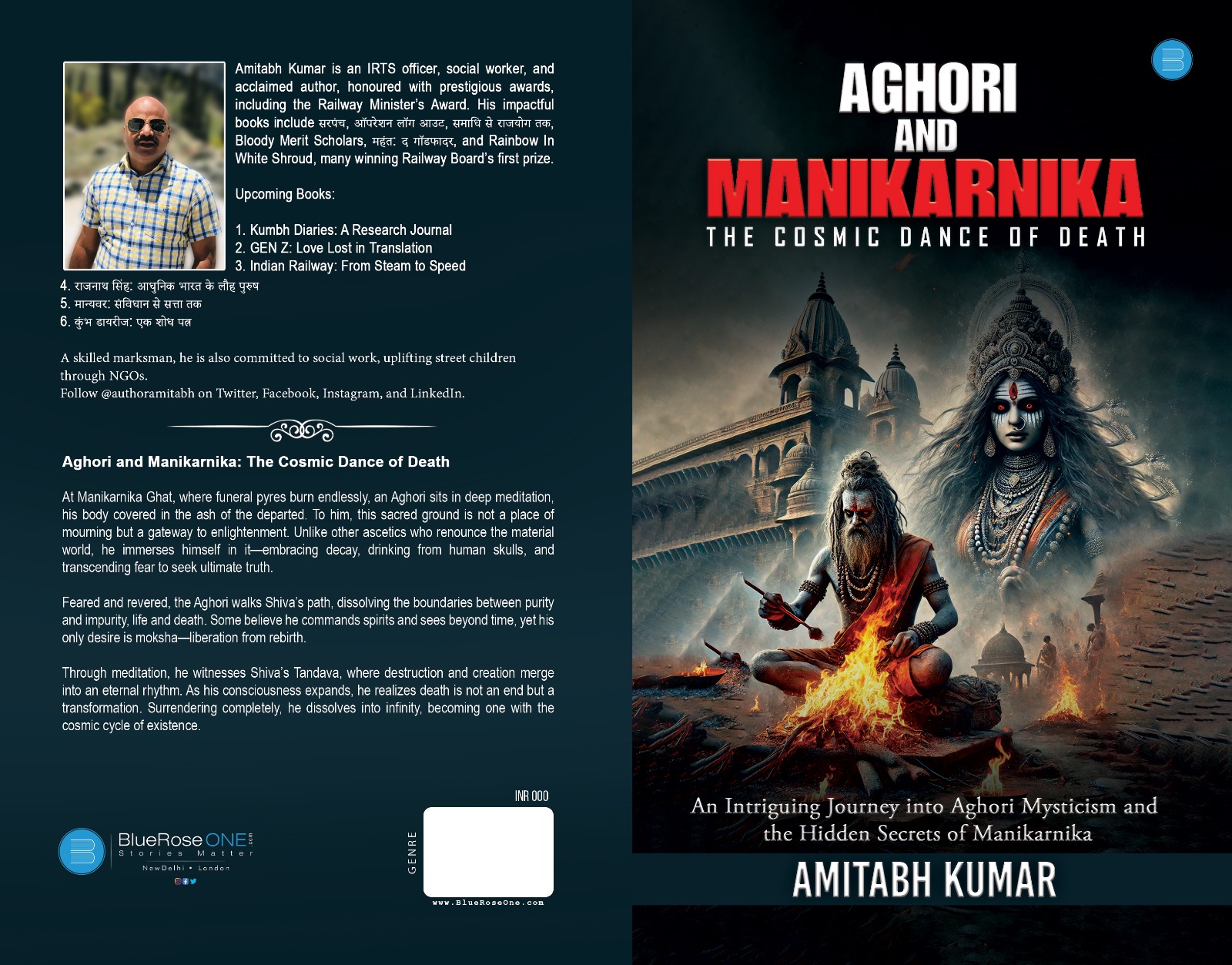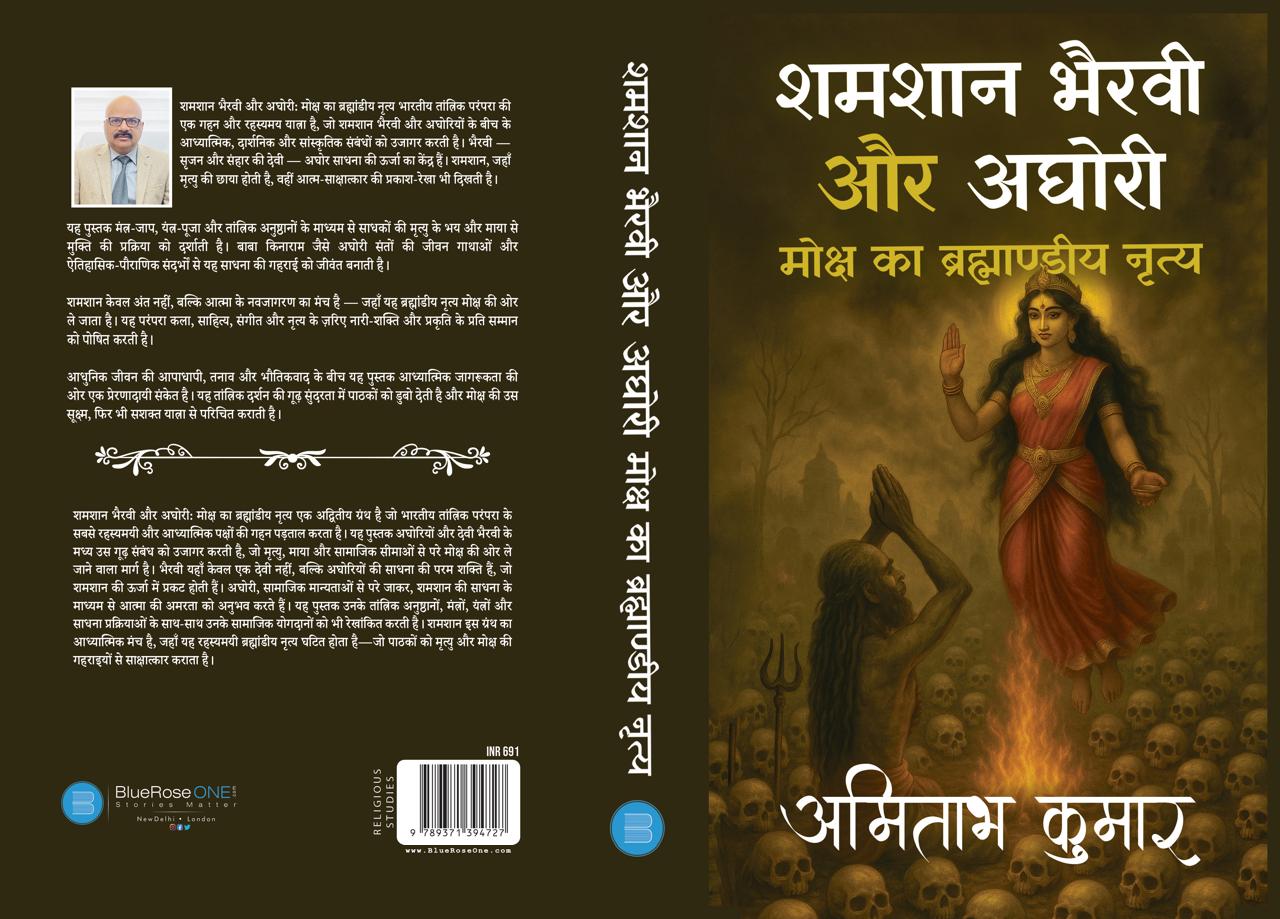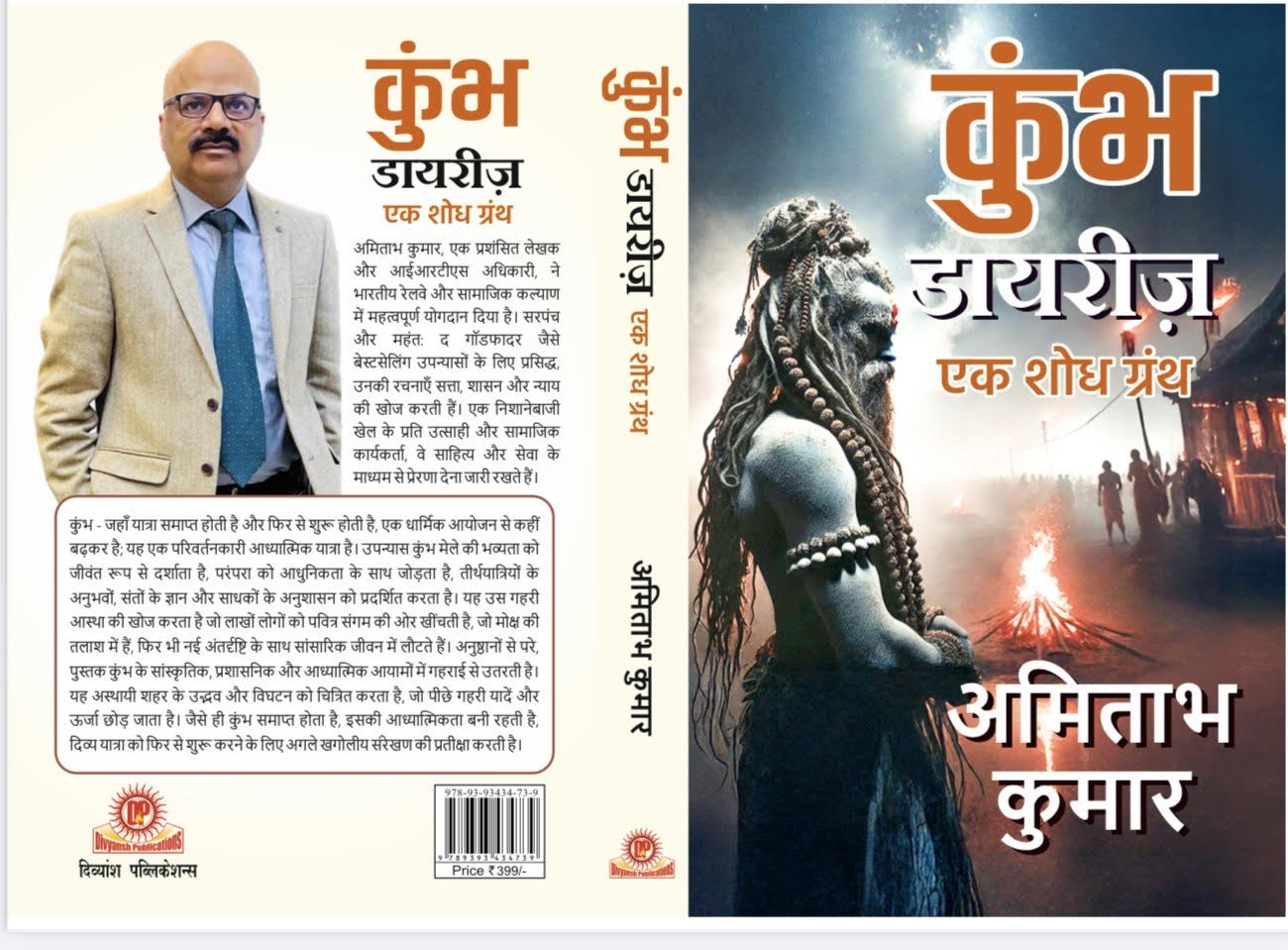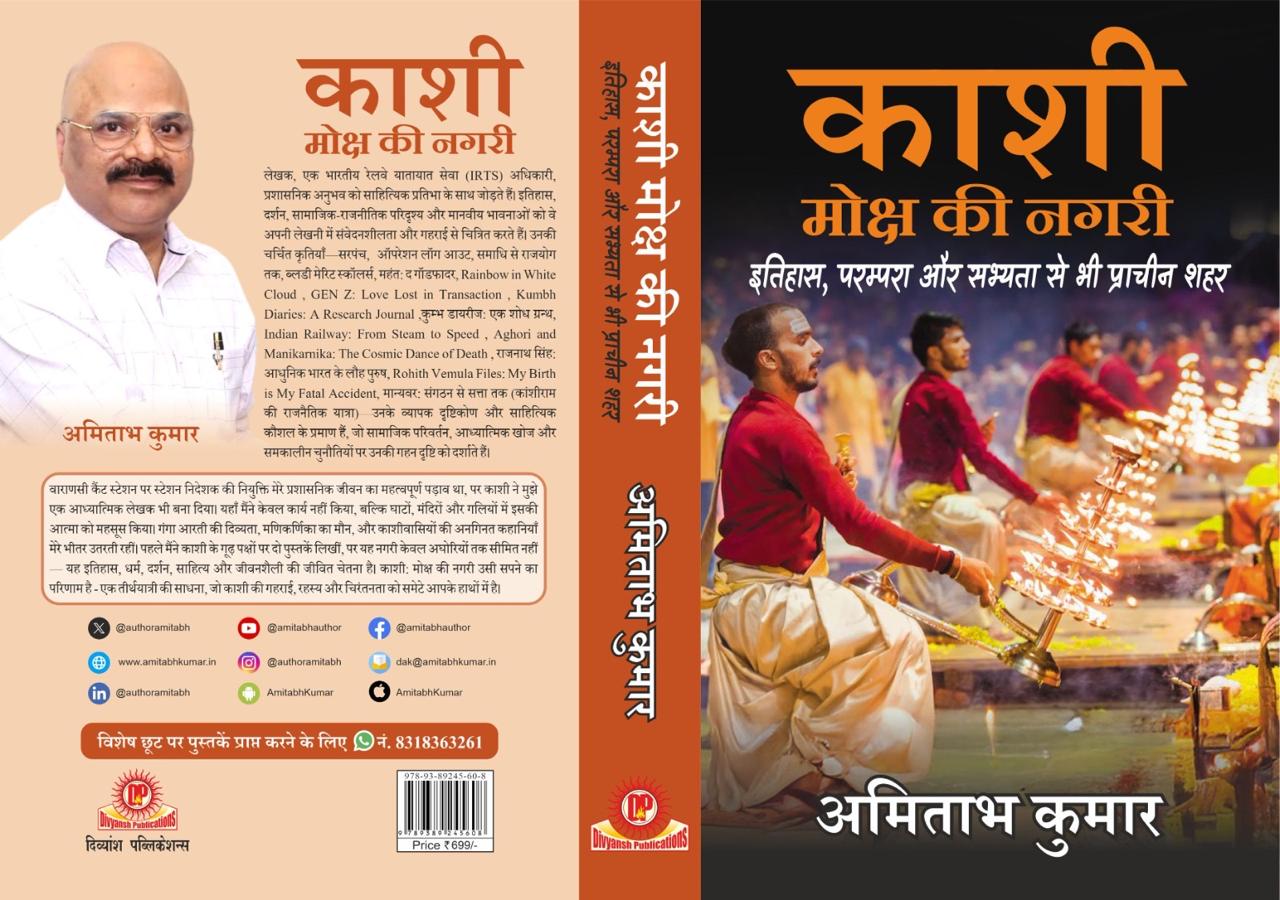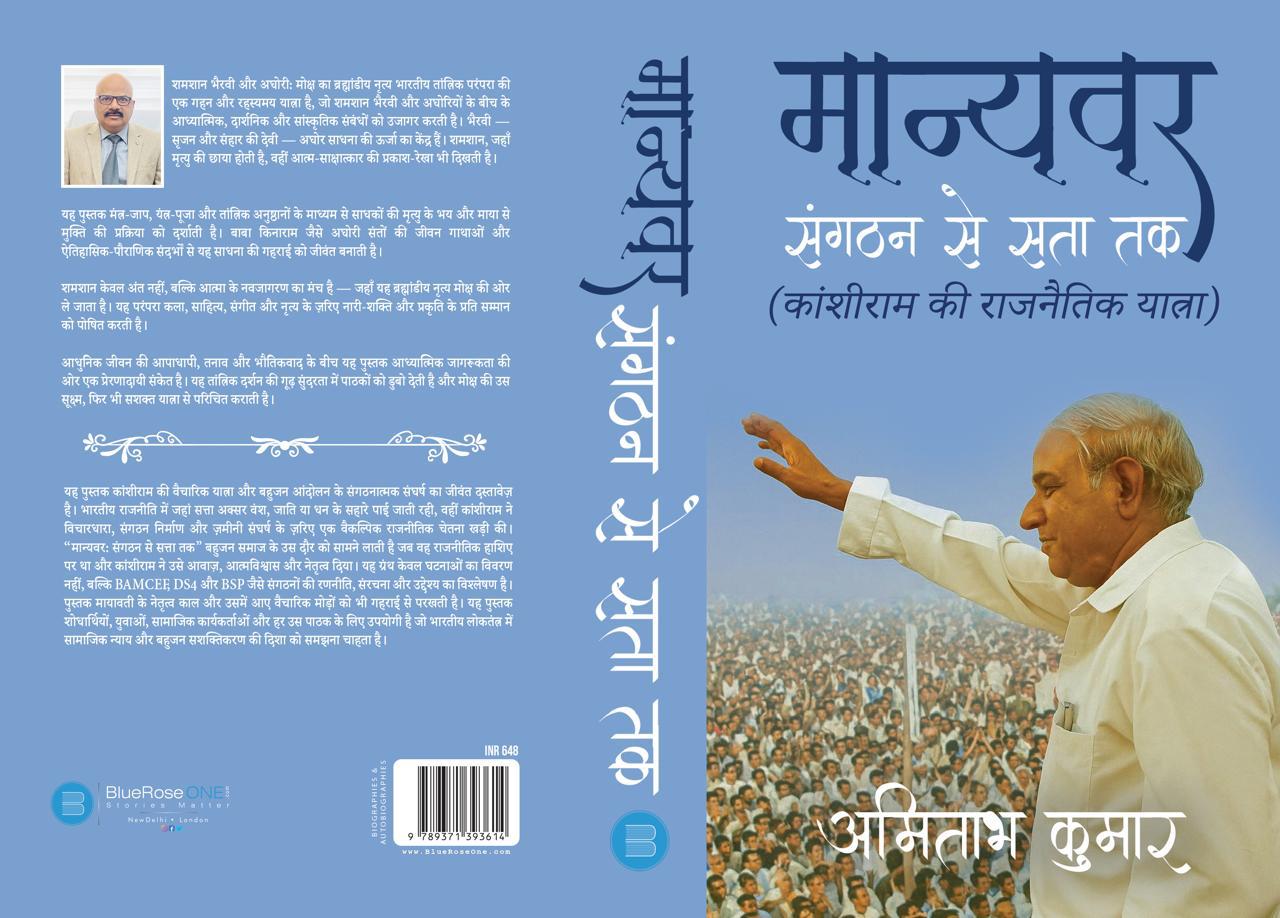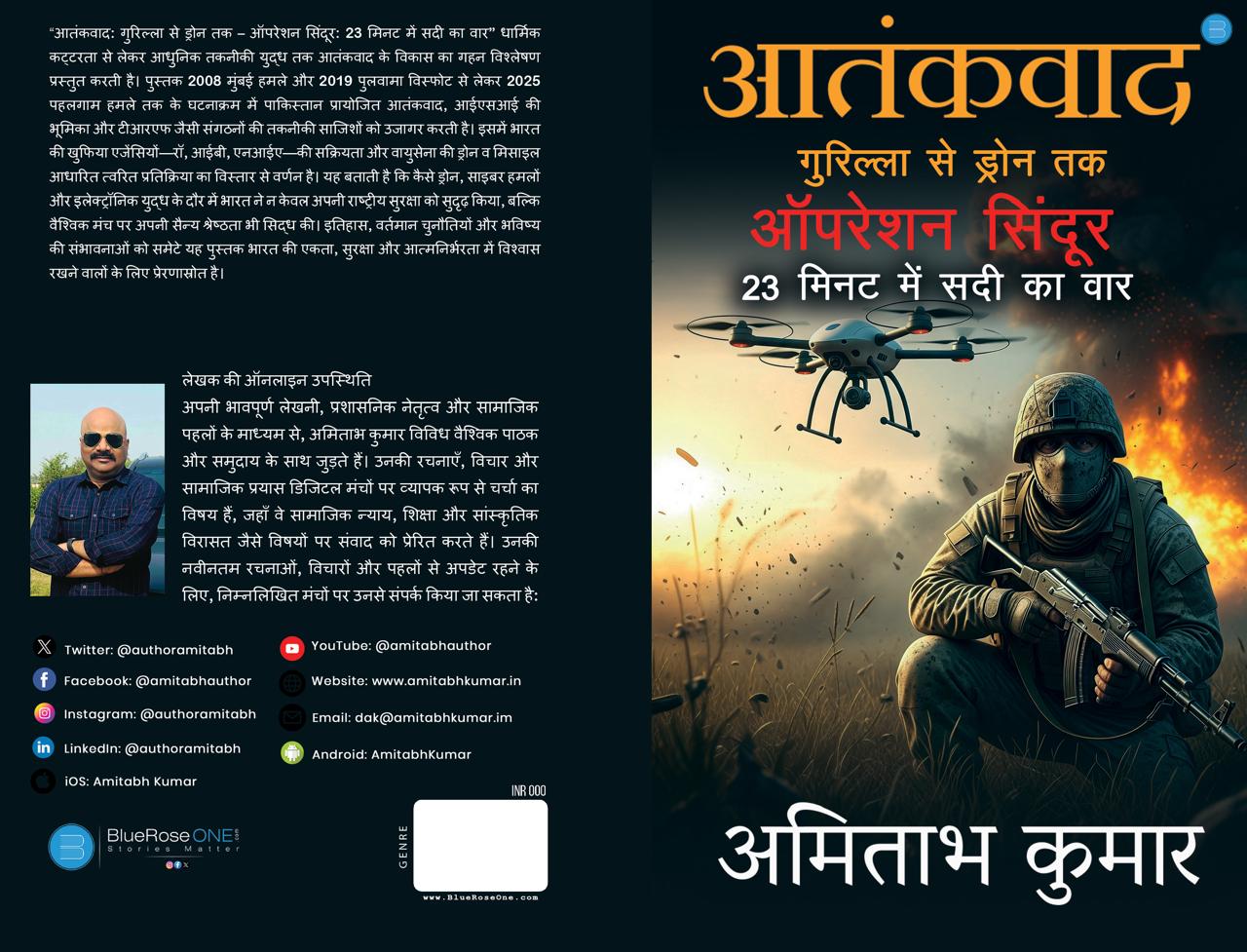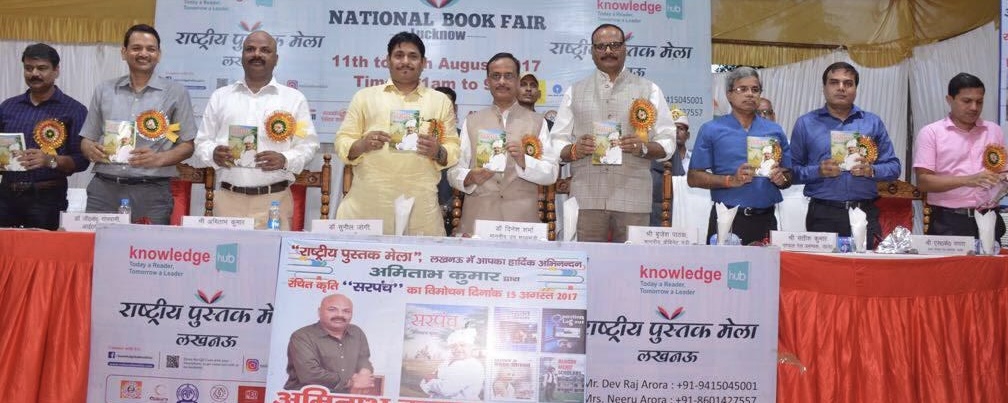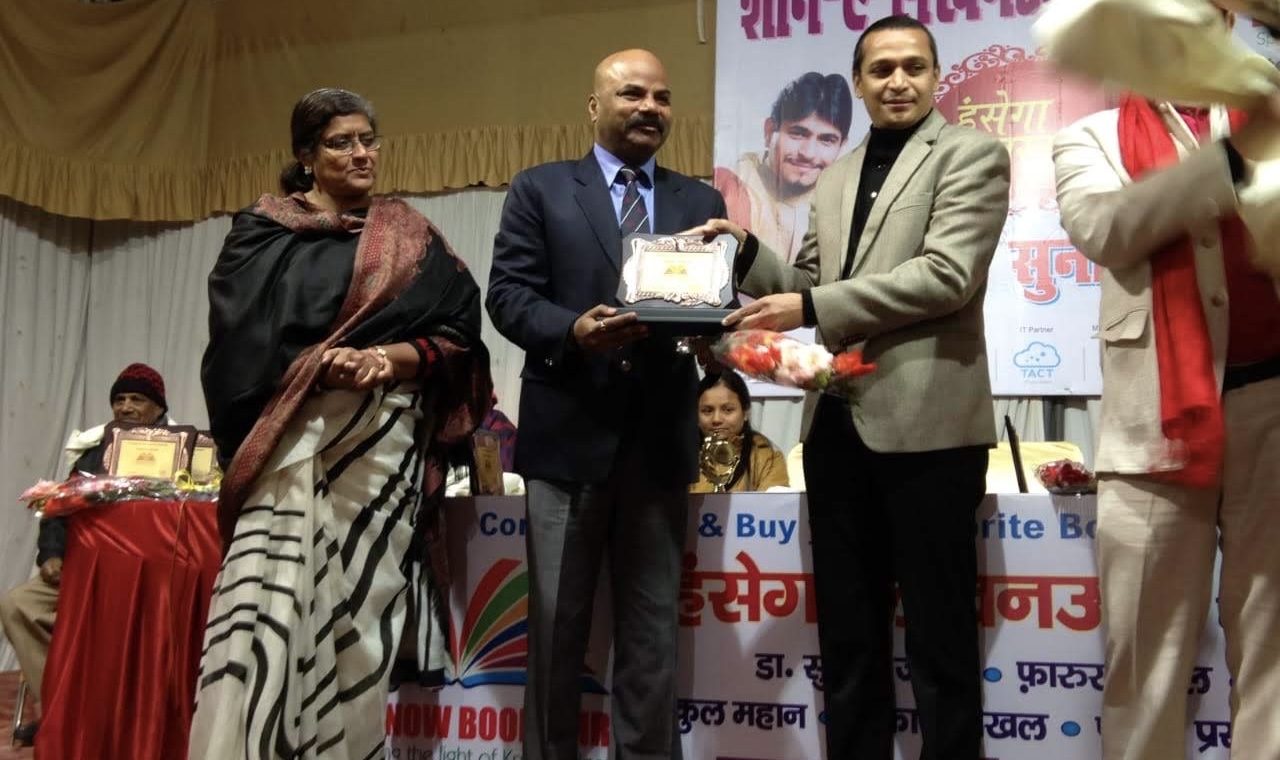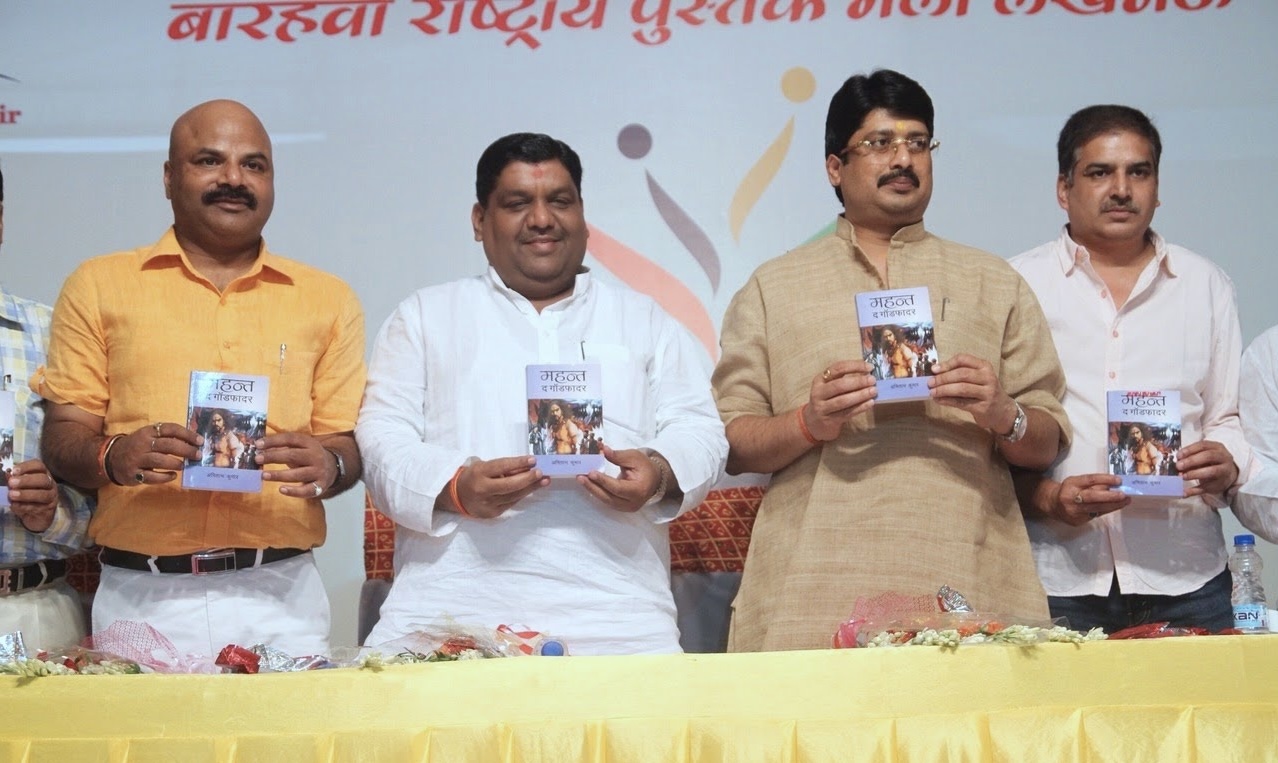लखनऊ
लखनऊ: शहर-ए-अदब (ज़ुबान, ज़मीर और ज़िंदगी का शहर)
लखनऊ कोई आम शहर नहीं, यह अदब की सरज़मीन है, जहाँ हर इमारत, हर गली, हर बाग़, हर पकवान और हर सलाम में एक तहज़ीब रची-बसी है। ‘लखनऊ: शहर-ए-अदब’ एक ऐसी किताब है जो पाठकों को इस शहर की उन परतों में ले जाती है जहाँ इतिहास महज़ तारीख़ नहीं, बल्कि ज़िन्दगी का लहजा बनकर सांस लेता है। यह किताब लखनऊ के दिल में उतरने का एक प्रयास है — उस दिल में, जहाँ नवाबी नफ़ासत, शायराना रवायत, मुग़लिया विरासत, और आधुनिक जीवनशैली मिलकर एक ऐसा रूप बनाते हैं जिसे दुनिया ‘लखनऊपन’ के नाम से जानती है।
इस पुस्तक में लखनऊ की सांस्कृतिक विरासत को उसकी संपूर्णता में प्रस्तुत किया गया है — चाहे वह बड़ा इमामबाड़ा की भूलभुलैया हो या हुसैनाबाद की बारादरी, तुनके-तुनके बजते ढोल के साथ निकलती मुहर्रम की ताज़ियादारी हो या गंगा-जमुनी तहज़ीब की रंगीनियाँ, हर अध्याय पाठक को इतिहास और वर्तमान के संगम तक ले जाता है। इस शहर की गंगा-जमुनी रवायत ने ही इसे वह रंग दिया है जिसमें हिंदू-मुस्लिम त्योहारों की खुशबू एक साथ घुलती है, और जहाँ मंदिरों की आरती और मस्जिदों की अज़ान एक ही फिज़ा में गूंजती है।
लखनऊ का खाना केवल स्वाद नहीं, एक विरासत है। इस पुस्तक में कुल्चा-नीहरी, टुंडे कबाब, शीरमाल, बाकरखानी, मक़्खन मलाई, और लखनऊ की चाय की उन गलियों की भी बात की गई है जहाँ हर निवाला एक कहानी सुनाता है। वहीं दूसरी ओर, अमीनाबाद की तंग गलियों, हज़रतगंज की शान, और गोमतीनगर के मॉल्स को जोड़कर यह किताब लखनऊ के शहरी बदलाव को भी दस्तावेज़ बनाती है — कैसे यह शहर परंपरा को थामे रखते हुए आधुनिकता से संवाद करता है।
यह किताब न सिर्फ़ इतिहास की तारीख़ों या सांस्कृतिक संदर्भों का संग्रह है, बल्कि एक ऐसा भावनात्मक अनुभव है जो पाठकों को यह सोचने पर मजबूर करता है कि लखनऊ को सिर्फ़ देखा नहीं जा सकता, उसे महसूसा जाता है। ‘पहले आप’ जैसी शालीनता से शुरू हुई बातचीत, कब्बाली और ठुमरी के सुरों में डूबी शामें, इत्र की महक से भीगी सुबहें और साहित्य, नृत्य, वास्तु, भोजन और भाषा की नफ़ासत — यही सब मिलकर इस पुस्तक को एक जीवंत शहर का साहित्यिक रूप बनाते हैं।
‘लखनऊ: शहर-ए-अदब’ एक ऐसी यात्रा है, जो समय, स्वाद, स्थापत्य और संजीदगी की गलियों से होती हुई लखनऊ के दिल तक पहुँचती है — उस दिल तक, जो आज भी कहता है — “पहले आप…”

THE PAHALGAM FILES
THE PAHALGAM FILES: SINDOOR - TECHNOLOGY MEETS TERROR
Book is the harrowing events of the Pahalgam terror attack on 22 April 2025, a meticulously planned assault by Pakistan-backed militants of The Resistance Front (TRF), an offshoot of Lashkar-e-Taiba, that claimed 26 civilian lives, mostly tourists, in the serene Baisaran Valley of Jammu and Kashmir. This book weaves a comprehensive narrative, blending the human tragedy, India’s resolute response through Operation Sindoor, and the broader implications for security, culture, and peace in the region.
The narrative begins with the historical context of terrorism in Jammu and Kashmir, tracing its evolution and the political shifts following the 2019 revocation of Article 370. It vividly details the attack’s execution, where terrorists, armed with M4 carbines and AK-47s, targeted Hindu tourists, exploiting religious identities to sow division. The book captures the stories of victims, survivors, and local heroes, such as the pony operator who sacrificed his life, highlighting the profound human cost and the Kashmiri community’s compassionate response, which included sheltering tourists and holding interfaith vigils.
India’s response, Operation Sindoor, launched on 7 May 2025, is a focal point, showcasing the nation’s technological and military prowess. The Indian Air Force’s precision strikes, using indigenous BrahMos missiles and Akash systems, targeted nine terror camps in Pakistan and Pakistan-occupied Kashmir, neutralising key operatives without civilian casualties. The operation, supported by advanced satellite imagery and intelligence, marked a strategic shift, emphasising decisive retaliation while maintaining diplomatic restraint, as evidenced by global support from the UN Security Council and allies like the U.S.
The book explores the attack’s ripple effects: an 80% drop in tourism bookings, economic strain on local livelihoods, and challenges to Kashmir’s cultural identity, Kashmiriyat. It details government efforts to restore stability, including enhanced security, community policing, and economic diversification, alongside diplomatic measures like suspending the Indus Waters Treaty. The narrative also examines the technological dimensions of modern terrorism, such as encrypted communications, and India’s counter-strategies, including AI-driven surveillance and cyber- defence.
Through poignant accounts of resilience, from families advocating justice to locals rebuilding trust, the book underscores India’s unified response across political, social, and global spheres. It reflects on lessons learned—strengthening intelligence, balancing security with civil liberties, and leveraging indigenous technology—while envisioning a path to peace through governance, education, and international cooperation. Pahalgam: Terror, Technology, and Triumph is a testament to India’s unyielding spirit, offering a compelling exploration of a nation’s journey from tragedy to triumph, dedicated to the victims and the brave soldiers who defend its honour.
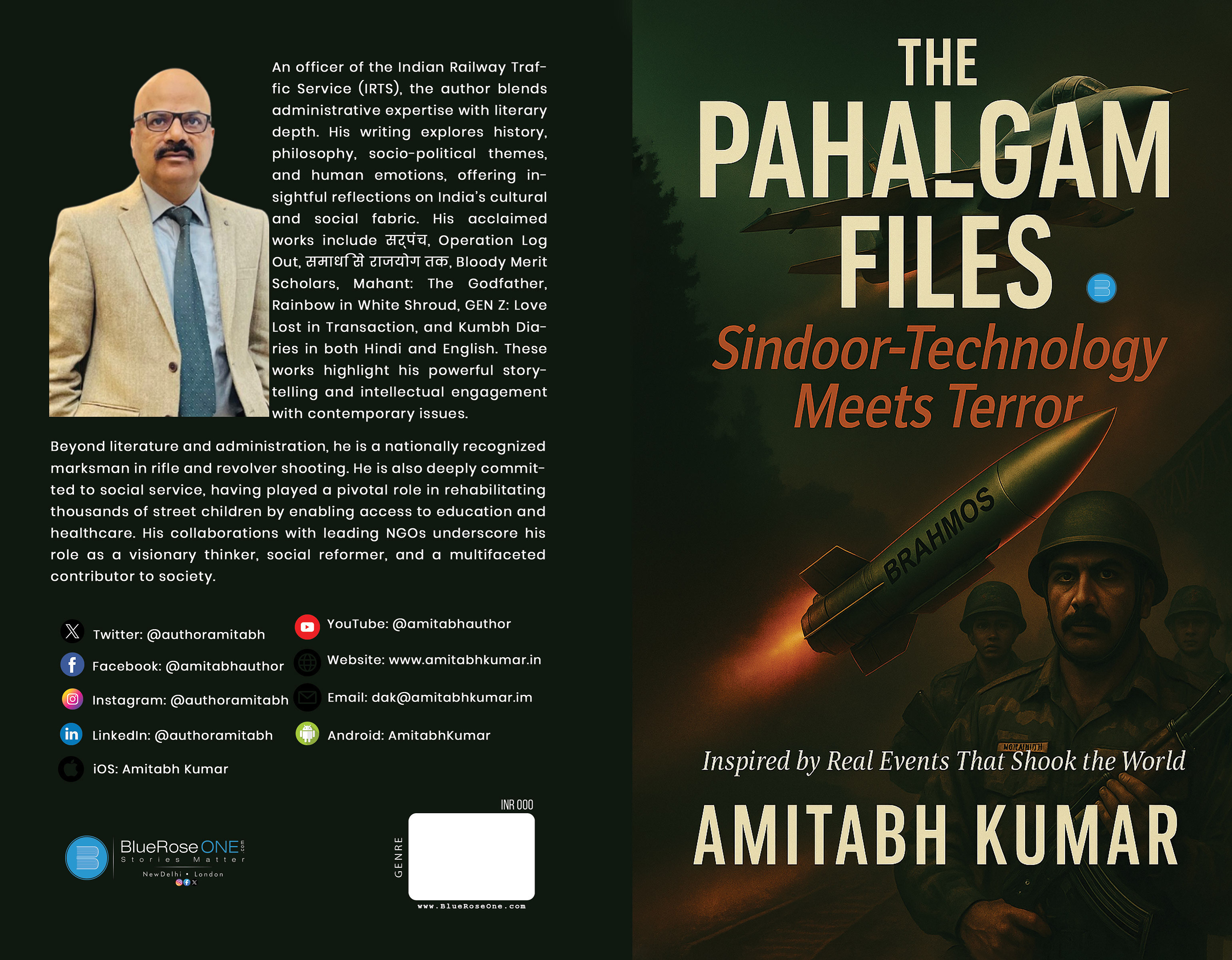
ROHITH VEMULA DOSSIER
Rohith Vemula Dossier: My Birth is My Fatal Accident (Campus Sketches of Discrimination)
Rohith Vemula Dossier: My Birth is My Fatal Accident (Campus Sketches of Discrimination) is a searing exploration of caste-based discrimination in India, anchored by the tragic death of Rohith Vemula, a Dalit scholar who took his own life in 2016 at the University of Hyderabad (UoH). This meticulously researched volume unveils the pervasive and insidious nature of casteism, not only within India’s higher education institutions but across government offices, urban and rural societies, and global diaspora communities. Through a blend of historical analysis, contemporary data, legal records, and personal narratives, the book exposes the systemic barriers that crush marginalised communities—Dalits, Adivasis, and Other Backward Classes (OBCs)—while celebrating their resilience and resistance. It is both a scholarly indictment of institutional casteism and a clarion call for transformative action to dismantle a centuries-old hierarchy that continues to shape India’s social fabric.
The book opens with the heart-wrenching story of Rohith Vemula, whose suicide sparked nationwide protests and galvanised a new wave of anti-caste activism. A brilliant PhD scholar, Rohith faced relentless discrimination at UoH, culminating in his suspension following clashes with upper-caste student groups, a move the Ambedkar Students’ Association (ASA) decried as casteist, though the university claimed procedural fairness. His poignant suicide note, declaring “My birth is my fatal accident,” became a rallying cry, shared over 50,000 times on social media. The dossier traces the aftermath, from Radhika Vemula’s tireless advocacy—through the 2019 Public Interest Litigation (PIL) alongside Abeda Tadvi to her rejection of the 2024 Telangana Police closure report denying Rohith’s Dalit identity—to the emergence of ‘Velivada’ as a symbol of resistance, hosting 500 attendees at its 2025 commemoration. Rohith’s tragedy serves as a lens to examine broader institutional failures, with the book documenting 115 student suicides in Indian Institutes of Technology (IITs) from 2022–2024, linked to unchecked caste bias.
Delving into the historical roots of caste, the book traces its origins from Vedic hierarchies, rigidified by colonial codification, to its modern manifestations. It critiques the superficial impact of post- independence policies, such as reservations, which face resistance, with only 5% of IIT faculty from Scheduled Castes (SC) or Scheduled Tribes (ST) despite mandated quotas. Contemporary data, including the National Crime Records Bureau’s (NCRB) 2024 report of frequent rapes against Dalit women and a 29.2% conviction rate under the SC/ST Act, underscores caste’s unrelenting brutality. The dossier highlights microaggressions in academia—80% of Dalit students report faculty bias—and exclusion in government offices, where reserved posts remain vacant. Urban caste segregation and rural atrocities, like the 2020 Hathras gang-rape, reveal the intersection of caste with gender and class, while global parallels, such as Japan’s Burakumin and Nigeria’s Osu, frame caste as a universal human rights issue.
The book amplifies voices of resistance, from Ambedkar’s intellectual defiance to modern activists like the National Campaign on Dalit Human Rights (NCDHR), which documented 5,000 caste atrocities in 2024. It chronicles the ASA’s expansion to 10 universities, mobilising 1,000 students annually, and global solidarity movements, including 2017 #DalitLivesMatter vigils and Harvard’s 2022 caste protections. Legal battles, such as the 2020 Cisco lawsuit in California and Seattle’s 2023 caste ban, reflect caste’s diaspora reach. The proposed Rohith Vemula Act, with Karnataka’s 2025 draft advocating penalties and sensitisation, embodies policy reform efforts, though only 40% of higher education institutions (HEIs) comply with 2025 UGC Equity Committee mandates. Digital platforms, with 25,000 #JusticeForRohithVemula posts in 2025, amplify these struggles, connecting local activism to global platforms like Dalit Camera.
Rohith Vemula Dossier: My Birth is My Fatal Accident (Campus Sketches of Discrimination) proposes a multifaceted strategy to dismantle caste: robust legal enforcement, mandatory caste sensitisation in education, equitable representation, and cultural shifts to uproot Brahmanical supremacy. It critiques institutional apathy, such as the 60% of central universities lacking Equal Opportunity Cells, and calls for anonymous grievance systems and caste-centred mental health support, given the 80% of Dalit students reporting anxiety. The book weaves narratives of defiance—Jan Sahas’s workshops reaching 100,000 Dalits, Dalit literature like Joothan, and urban resistance in slums—into a vision for a casteless society where potential, not birth, defines one’s worth.
This dossier is both a scholarly lament and a revolutionary manifesto. It challenges readers to confront their complicity in caste’s persistence, urging fierce action to forge a nation where dignity is universal. Rohith’s story, one spark among millions, kindles a blaze for justice, making Rohith Vemula Dossier: My Birth is My Fatal Accident (Campus Sketches of Discrimination) an essential text for scholars, activists, and anyone committed to dismantling systemic oppression.
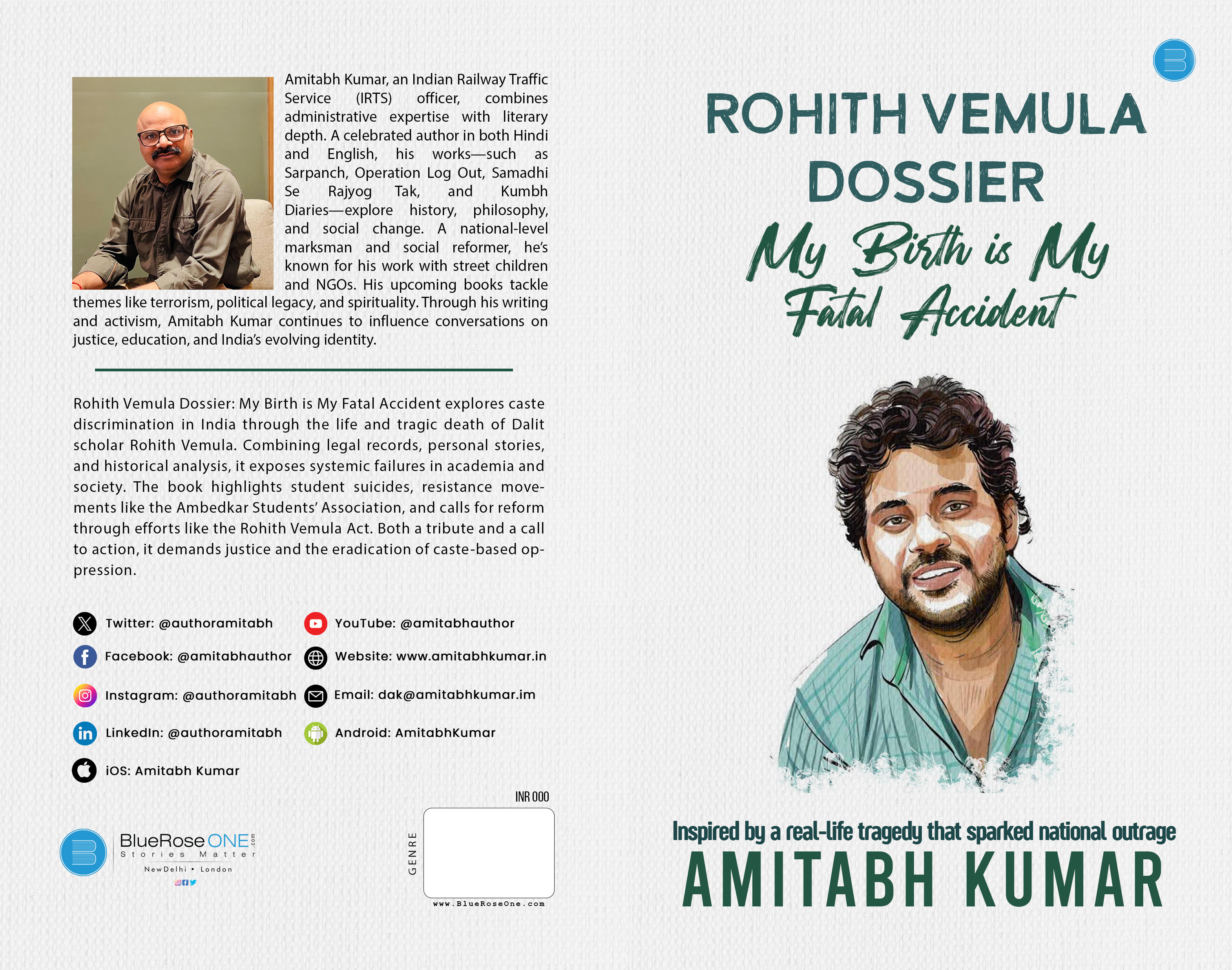
KUMBH DIARIES
Kumbh - Where the Journey Ends, and Begins Again is more than a religious event; it's a transformative spiritual journey. The novel vividly captures the grandeur of the Kumbh Mela, blending tradition with modernity, showcasing pilgrims' experiences, saints' wisdom, and seekers' discipline. It explores the deep faith that draws millions to the sacred confluence, seeking salvation yet returning to worldly life with renewed insight.
Beyond rituals, the book delves into the Kumbh's cultural, administrative, and spiritual dimensions. It portrays the temporary city's emergence and dissolution, leaving behind profound memories and energy. As the Kumbh ends, its spirituality endures, awaiting the next celestial alignment for the divine journey to begin again.
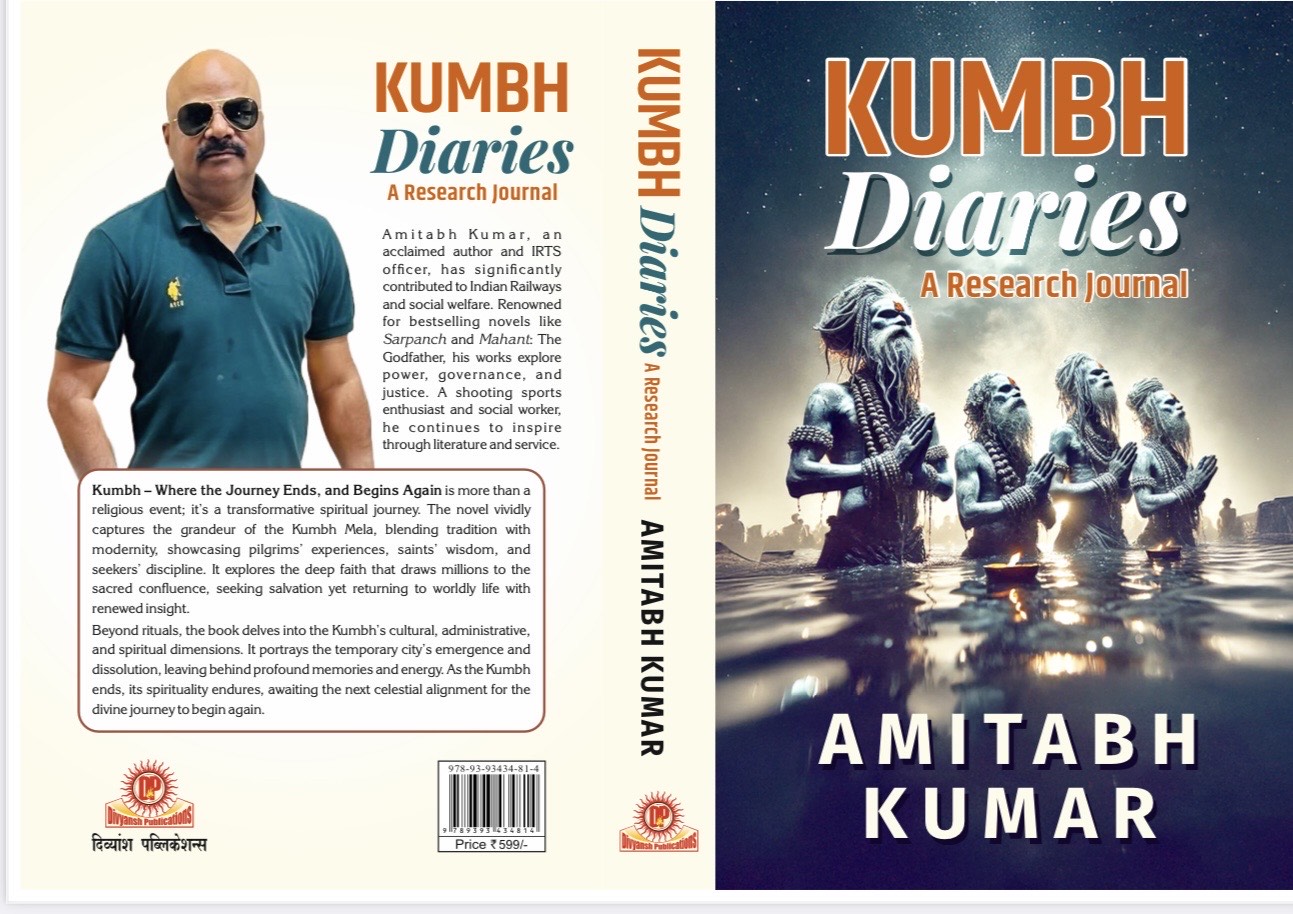
INDIAN RAILWAYS
Synopsis “Indian Railways: From Steam to Speed” is a fascinating chronicle of the extraordinary journey of Indian Railways, tracing its transformation from the age of steam locomotives to the era of high-speed trains. This book delves into the historical milestones, technological innovations, and infrastructural advancements that have shaped one of the world’s largest and most dynamic railway networks.
The narrative begins with the historic first train journey in 1853, when a steam-powered locomotive ran between Mumbai and Thane, marking the foundation of Indian Railways. It explores the colonial expansion of railroads, their role in economic development and India’s freedom struggle, and the post-independence restructuring that led to nationalisation, modernisation, and electrification.
As the book progresses, it examines key technological shifts, from steam to diesel and electric engines, from manual signalling to automated traffic control, and from traditional coaches to high-speed luxury trains like Vande Bharat Express and the upcoming bullet trains. It highlights crucial innovations, including metro rail systems, dedicated freight corridors, AI- driven safety measures, and digitisation of railway services.
Beyond infrastructure and technology, the book offers a human perspective, honouring the 12 lakh railway employees who work tirelessly to keep the network running. It sheds light on the relentless dedication of train-running staff, who ensure seamless operations 24/7, often sacrificing personal time and enduring hardships for the smooth functioning of the system. The book also pays tribute to railway workers who lost their lives preventing accidents and ensuring passenger safety.
Looking to the future, “Indian Railways: From Steam to Speed” explores the ambitious vision of 100% electrification, hydrogen-powered locomotives, ultra-high-speed rail corridors, and AI- integrated operations. It presents a compelling vision of how Indian Railways is embracing modernisation while preserving its legacy, ensuring that it remains the backbone of India’s transportation system.
This book is not just a history of Indian Railways—it is a story of resilience, progress, and transformation, a tribute to the past, present, and future of one of the world’s most iconic railway networks.
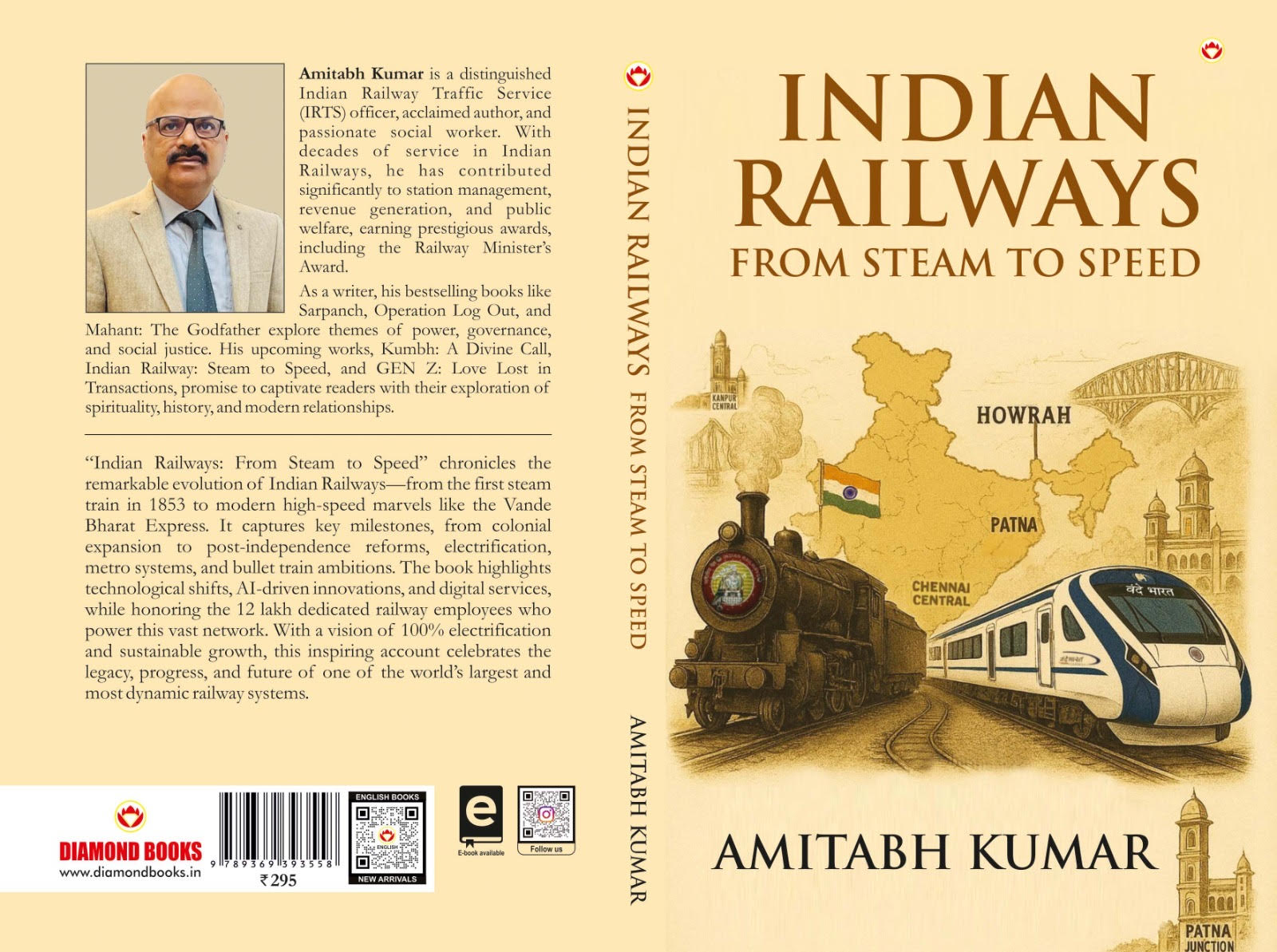
Rainbow In White Shroud
A novel based on circumstances and development in rural India post-Independence, and throws light on a number of serious issues such as orthodox practices, superstition, casteism, illiteracy, poverty, class difference, exploitation of underprivileged section of society by the rich, among many others. Many people in rural India are ignorant of their 'right to vote'. This novel throws light and depicts the life of a strong will-powered young widow of a protagonist, who loses his life in an aEempt to bridge the gap between two sections of the society, and how she struggles to fulfil the dream of her husband all alone. It is her fight to defend her self-respect.
Her journey as a woman to create awareness in the society, equality, and justice is remarkable. A perfect amalgam of love, conspiracy, sensitivity, political tricks and revolt. The novel is no less fascinating than a Bollywood potboiler. Amitabh Kumar, presently working in Indian Railways, was born in Lucknow (UEar Pradesh). Some of his notable creations include 'Bloody Merit Scholars,' 'Operation Log Out', and 'Mahant – The Godfather'.
An author is known for his/her unparalleled skills and mastery over depicting characters in the best light and as needed in the plot of their novel. He has beautifully sketched and illustrated the rural life and social scenario of the rural UP region during the 1960s. People of that era lived happily in their own way despite challenges and dearth of amenities. The journey of an individual struggling for the well being of society and her own identity has been illustrated in the novel.
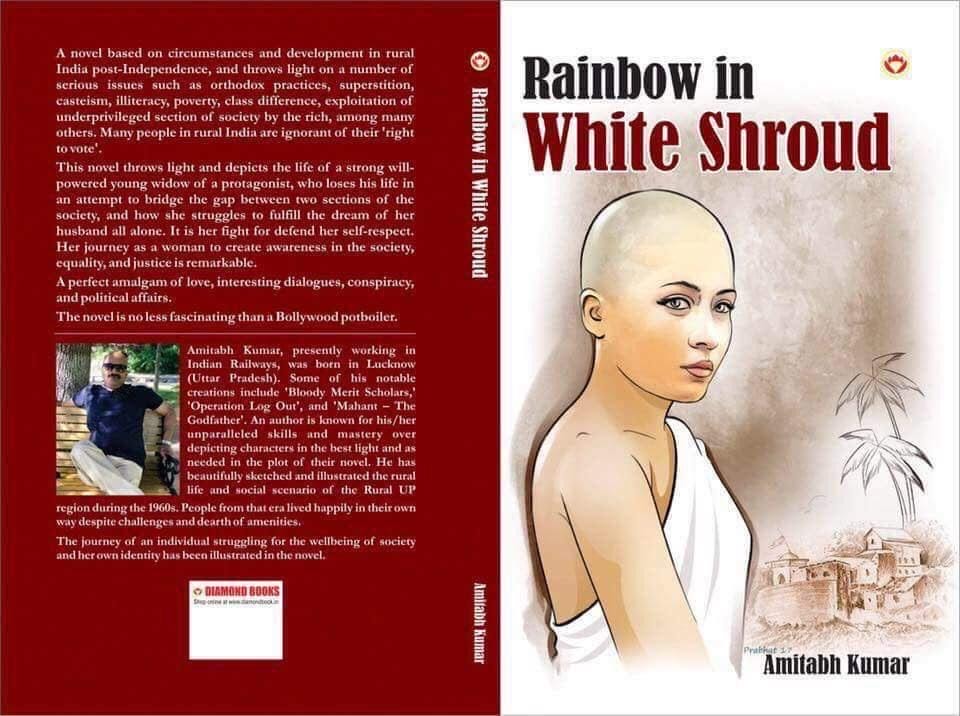
Mahant The God Father
सूचना और प्रौद्योगिकी के आधुनिक समय में भी अनपढ़ और अशिक्षित क्या, पढ़े-लिखे और तथाकथित सभ्य लोग भी धर्म के नाम पर अपना सब कुछ लुटा रहे हैं। लोगों की धार्मिक भावनाओं का लाभ लेने के लिए आज धर्म के ठेकेदारों में होड़ मची हुई है।
धर्म के नाम पर ये धर्म के ठेकेदार धर्म का व्यवसाय करके अकूत संपत्ति एकत्रित कर, विलासिता पूर्ण जीवन जी रहे हैं। यह बात अब सार्वजनिक हो गई है कि कई तथाकथित बड़े धर्मगुरु अनेक अपराधों में सक्रिय रूप से लिप्त हैं। सन् साठ और सत्तर के दशक में ये तथाकथित धर्मगुरु परोक्ष रूप से राजनीति और अपराध को नियंत्रित करते थे।
अब प्रत्यक्ष रूप से राजनीति में आकर शासन कर रहे हैं और सक्रिय रूप से विभिन्न अपराधों में लिप्त हैं। प्रस्तुत उपन्यास धर्म के इन विभिन्न रूपों को दिखाने का एक छोटा प्रयास है।
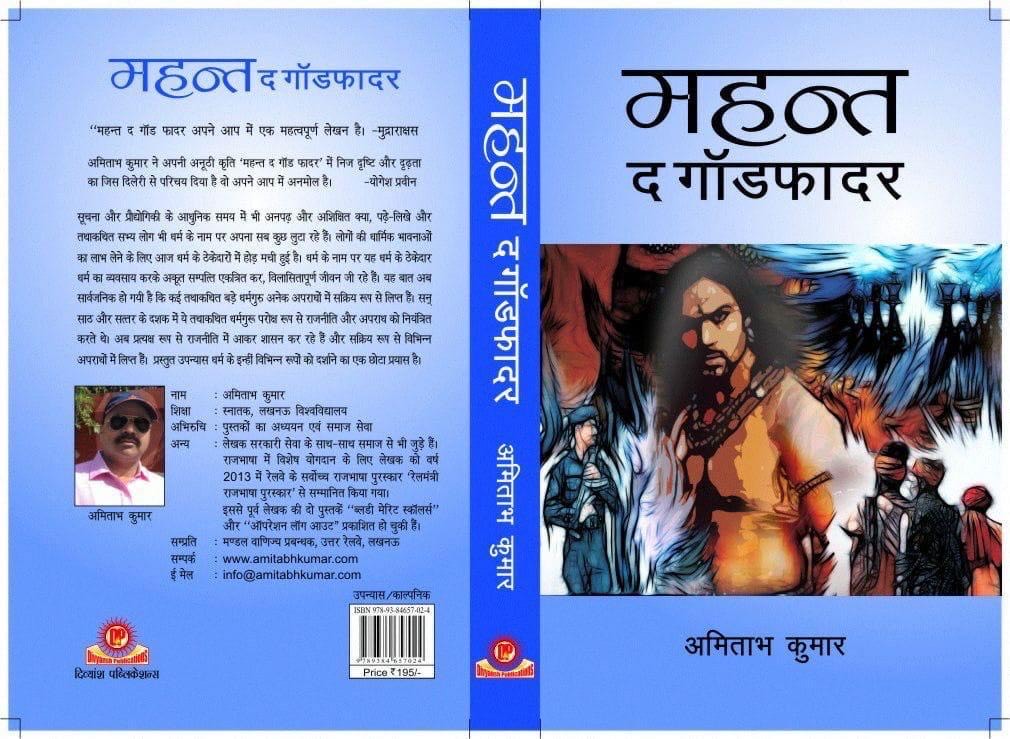
Sarpanch PB
सरपंच:
'सरपंच' स्वतंत्रता प्राप्ति पश्चात के प्रगतिशील भारत की ग्रामीण पृष्ठभूमि पर आधारित उपन्यास है।
जहां भारत के अन्य गांवों की तरह ही रूढ़िवादिता, अंधविश्वास, जातिवाद, तिरस्कार और उच्च व धनी वर्ग द्वारा शोषित, निम्न वर्ग की समस्याएं हैं। गांववासी अपने मताधिकार से अनभिज्ञ हैं, जिसका फायदा उच्च वर्ग द्वारा हमेशा से उठाया जाता रहा है। ऐसे में निम्न वर्ग के एक युवक का अपनी प्रगति व पुरातन व्यवस्थाओं को बदलने का संघर्ष है। लेखक ने उत्तर भारतीय परिवेश का जीवंत चित्रण किया है। प्रेम, संवेदनाओं, साजिशों, राजनीतिक चालों और विद्रोह से पूर्ण इस कहानी में सिनेमा जैसी रोमांचकता और गति है।
विधवा की श्वेत कथा:
उपेक्षित उत्तर भारत के एक गांव के दो वर्गों के बीच की प्रतिद्वंद्विता की कहानी है। दो वर्गों की इस प्रतिद्वंद्विता व बीच की खाई को पाटने के प्रयास में अपनी जान गंवाने वाले एक निम्न वर्ग के युवक की विधवा के दृढ़ संकल्प का यह एक दिलचस्प दस्तावेज़ है।
अपने पति को खोने के पश्चात एक उपेक्षित विधवा सती का अकेले, अपने पति के अधूरे सपनों व उद्देश्यों को पूरा करने के साथ-साथ स्वयं के अस्तित्व को बचाने व समाज में एक सामाजिक चेतना, जागरूकता, समानता एवं प्रगति के लिए किए गए संघर्ष की यह अकल्पनीय गाथा है।
अमिताभ कुमार पेशे से रेलवे अधिकारी हैं।
उन्होंने ‘ब्लडी मेरिट स्कॉलर्स’, ‘ऑपरेशन लॉग आउट’, ‘महंत – द गॉडफादर’ आदि उपन्यास लिखे हैं। लेखक समाज के अंतिम व्यक्ति की व्यथा को अपनी बेबाक शैली से उकेरने के लिए जाने जाते हैं। इस पुस्तक में उन्होंने साठ के दशक में पूर्वी भारत के ग्रामीण समाज को दर्शाया है। उस काल में लोग अनेक अभावों में रहते हुए भी अपनी परिस्थितियों में संतुष्ट रहते थे। सामाजिक और राजनीतिक परिवर्तन के इस दौर में, समाज का एक उपेक्षित व्यक्ति संघर्ष करके लोगों का नेतृत्व करता है और उनकी संघर्षशील बाधाओं को पार करके समाज की उन्नति का मार्ग प्रशस्त करने का प्रयास करता है।
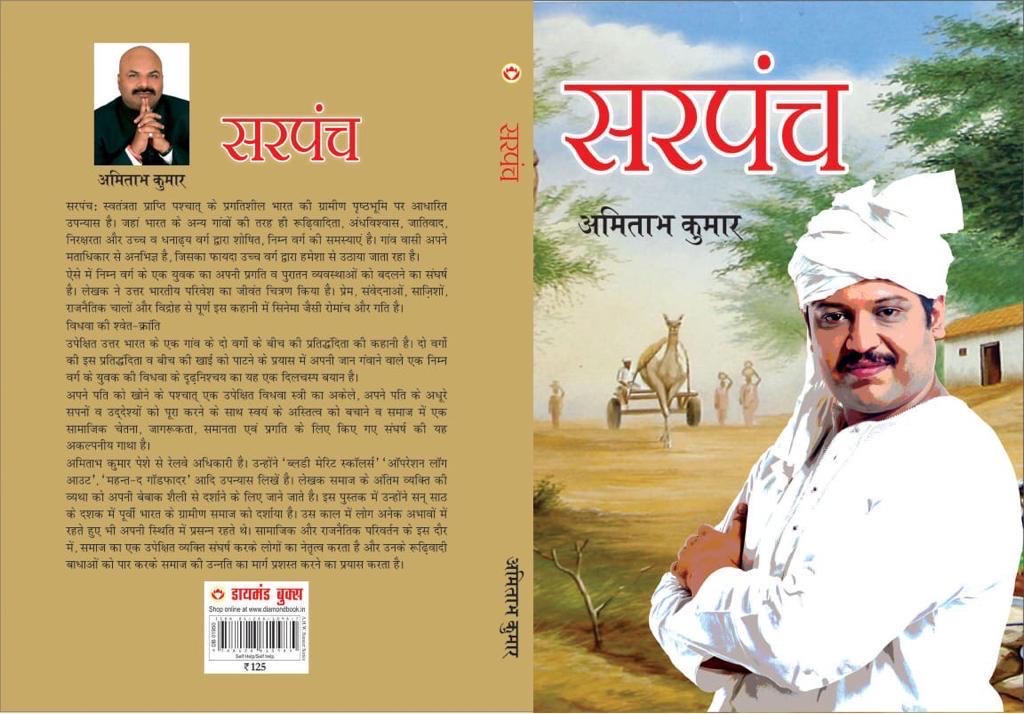
Gen Z
Gen Z: Love Lost in Transactions is a heart-wrenching novel that explores the shift in modern relationships, where ambition and self-interest overshadow love and family connections. It follows the story of parents who dedicate their lives to their children, sacrificing their own comforts for their success. However, as the children grow older, their emotional detachment replaces the unconditional love they once received.
Gen Z: Love Lost in Transactions is a powerful, thought-provoking novel that forces readers to question what modern success really means. It sheds light on a generation that chased ambition but lost relationships, that gained the world but lost the people who mattered.
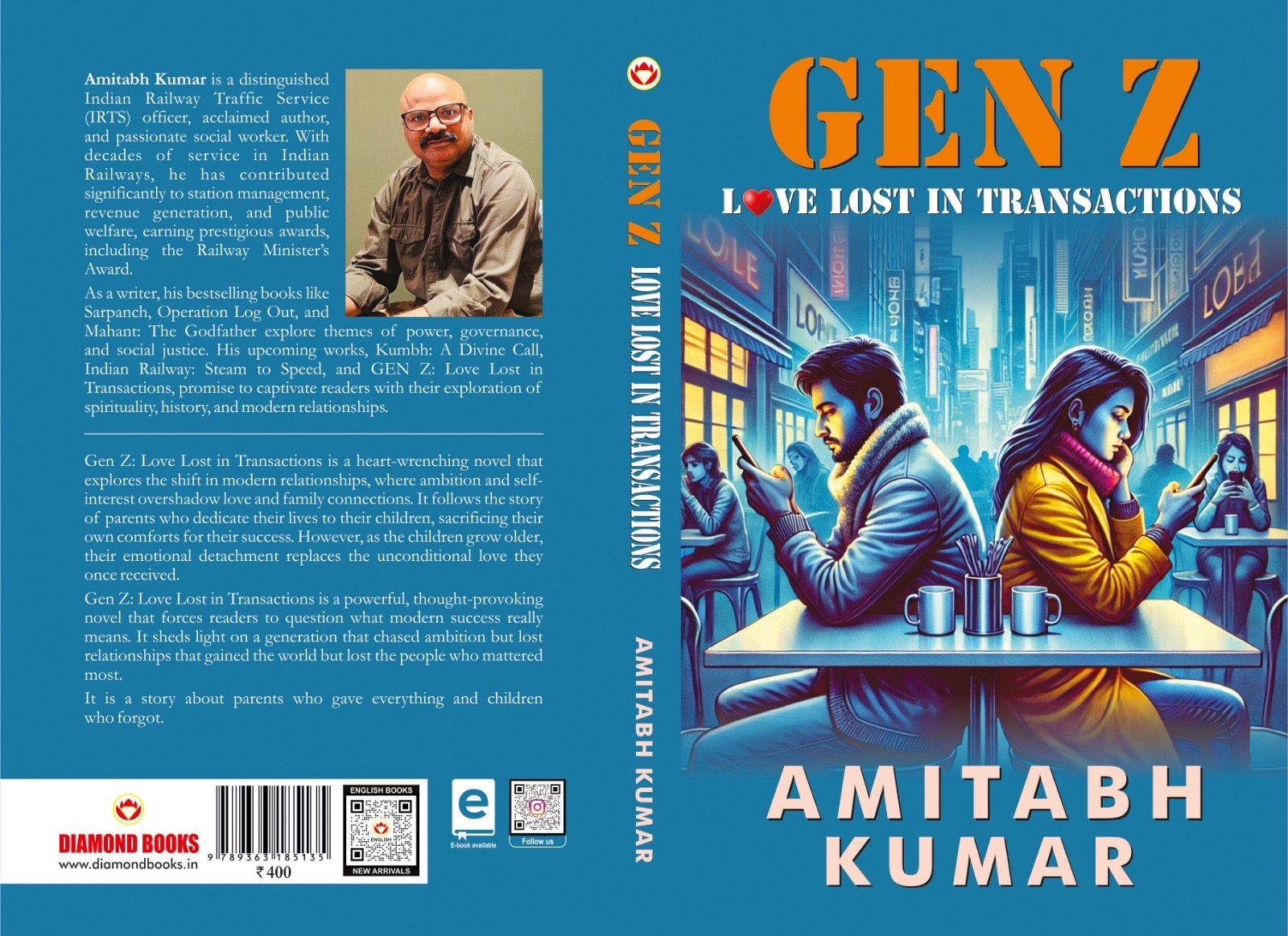
Samadhi Se Rajyog Tak
तथ्य यह है कि कथानक में एक ऐसे धर्मगुरु की कल्पना की गई है, जिनका धर्मगुरु बनना महज़ एक परिस्थिति वश संयोग होता है। किंतु वह धर्मगुरु अथवा मठ का महंत बनने के बाद लोग उन्हें धर्म एवं महंत के रूप में आत्मा की शक्ति को मानने लगते हैं। वचन, दर्शन, साधना, भंडारे, पूजा, पाठ तक सीमित नहीं रहते, अपितु श्रद्धालुओं की अपार आस्था व ईश्वर की शक्ति का उपयोग करके वह न केवल सामाजिक बल्कि राष्ट्रीय रूप से देश व विदेश की राजनीति में अपनी व अन्य धर्मगुरुओं की उपस्थिति दर्ज कराते हैं। और राजनीति के माध्यम से अपने श्रद्धालुओं व आस्था रखने वालों की सरकार से अपेक्षाओं को न केवल पूरा करते हैं, बल्कि अपनी कार्यशैली से धर्म और राजनीति के गठजोड़ के आलोचकों को निरुत्तर कर देते हैं।

Rajnath Singh: The Iron Man of Modern India
“Rajnath Singh: The Iron Man of Modern India” offers a factual and insightful narrative of one of India’s most influential contemporary leaders. The book traces Rajnath Singh’s journey from his humble beginnings, through his association with the RSS, and rise within the Bharatiya Janata Party (BJP).
It explores his significant roles as Chief Minister of Uttar Pradesh, Home Minister, and Defence Minister of India, presenting an analytical view of his policy decisions and leadership style. His contributions to national security, the fight against terrorism, and the promotion of self-reliant defense production under Atmanirbhar Bharat are discussed in detail.
Combining political analysis with historical context, the book paints a comprehensive portrait of a leader who continues to shape the destiny of modern India.
A must-read for students of political science, public administration, and anyone interested in India’s evolving leadership landscape.
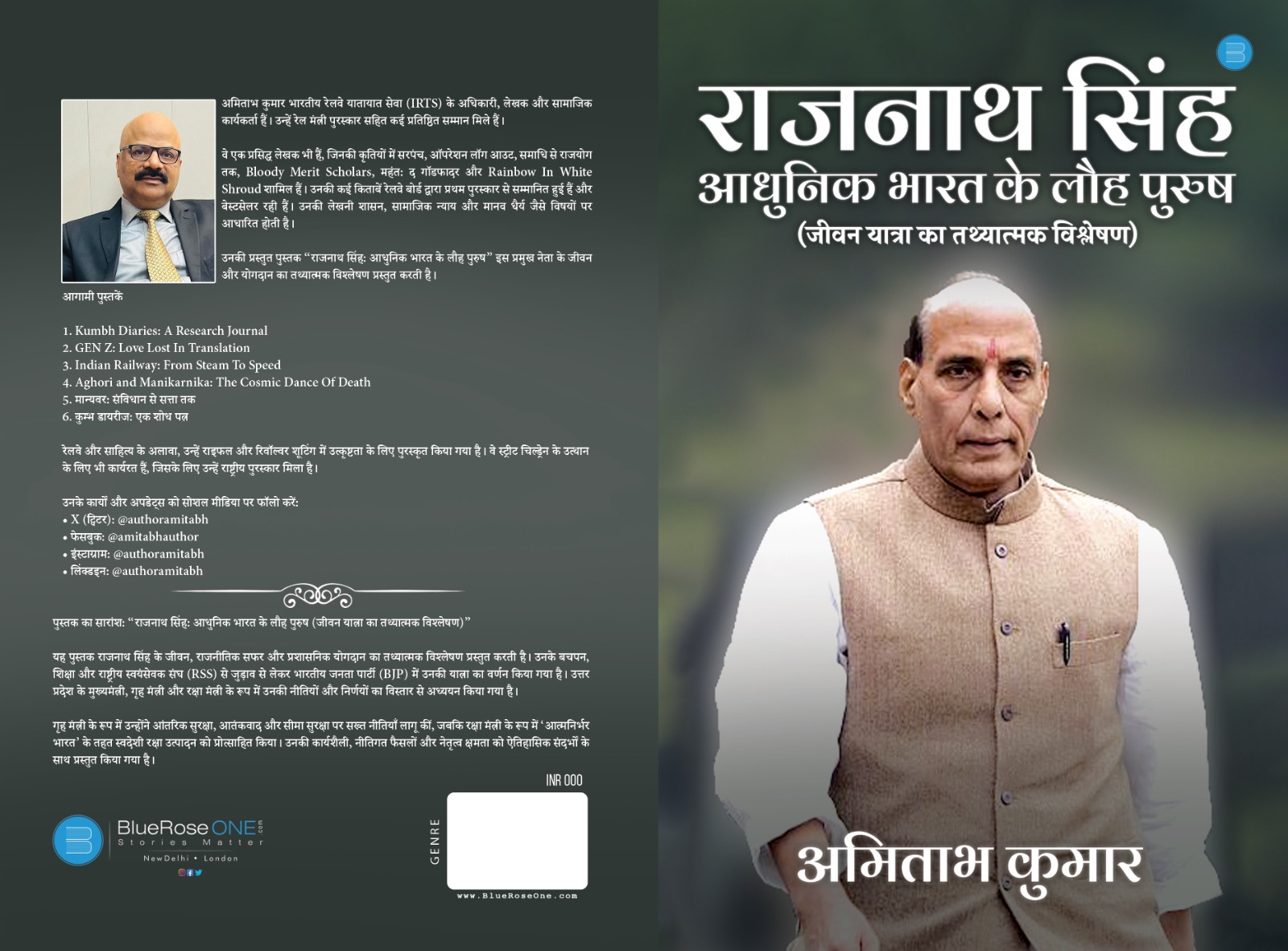
Aghori and Manikarnika: The Cosmic Dance of Death
On the sacred grounds of Manikarnika Ghat, where funeral pyres blaze day and night, an Aghori sits, cloaked in ash and silence. But to him, this is no place of sorrow — it’s a gateway to enlightenment.
This powerful narrative unveils the world of the Aghori, a mystic who embraces what society fears — decay, death, impurity — to transcend the cycle of rebirth. As he meditates amidst the burning, he surrenders himself to the Tandava — Shiva’s cosmic dance of destruction and creation.
In these hauntingly poetic pages, Amitabh Kumar explores the essence of moksha, the illusions of life and death, and the dissolution of ego into the eternal. Aghori and Manikarnika is not just a book — it is a spiritual immersion, a philosophical exploration, and a glimpse into the profound mysteries of existence.
